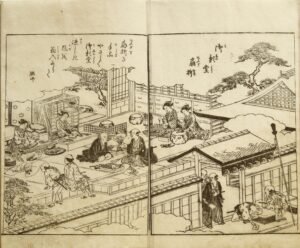[Tenmei 6 (1786)] – Tenmei 7 (1787).
11 volumes 4to [270 x 186 mm] printed on Japanese mulberry or rice paper. Sino-Japanese text. Circular stamp at the beginning of each volume. 327 double-page engravings and 91 full-page engravings. Preserved in their original pale blue wrappers sewn the Chinese manner. Stitches renewed. Volumes formerly numbered in ink on the cover with Chinese numerals. Modern blue cloth protecting chemise. Contemporary binding.
Rare first edition of this exceptional guidebook dedicated to Kyoto and its surroundings, published just two years before the city was ravaged by the devastating fire of 1788.
This book, of great importance for the history of the edition of Japanese books, was an absolute best-seller when it came out. It inaugurated the series known as “famous places of interest”. The first 6 volumes are dated An’Ei 9 (1780) but in reality they were not published until Tenmei 6 (1786). The first series, published in 1786 in 6 volumes, was so successful that the author undertook to publish five additional volumes in the following year: the Shui-Miyako Meisho Zue (1787).
Birthplace of the Japanese culture, the imperial capital of Kyoto was the symbol of pride and power in Japan for nearly a thousand years. The city is surrounded by mountains, where hundreds of Buddhist temples and monasteries, and Shinto sanctuaries were built. The center of the Imperial city was almost entirely destroyed in a terrible fire in 1788: only the temples and gardens, which were located on the surrounding mountains, were spared from destruction.
The book represents the city just before the Great Fire. After the reconstruction, Miyako will be renamed Kyoto. Therefore, this book is the best description of the imperial capital as it was for nearly a thousand years, until 1788. The descriptions within the book by Akisato rito (1776-1830) are a source of fascinating and very moving information, of incomparable value knowing that the city almost completely disappeared only two years after the publication of the work. A perfect guidebook of the city of Kyoto and its surroundings, the work of Akisato provides a detailed description of the city, its people and customs of the region.
The abundant illustration consists of 418 woodcuts, including 91 in full-page and 327 on double-page, executed by Takehara Shunchôsai Nobushige (1772-1801), the most famous illustrator of his time. The engravings mostly show Buddhist temples and Shinto sanctuaries, religious ceremonies, funeral processions, New Year celebrations, the Emperor’s processions through Kyoto, scenes of daily life, portraits of sellers and artisans, and many views of aristocratic and imperial domains. The representations of sites include the Honganji monastery built in the 10th century, the temple of Sanjusangendo with its 1001 statues of Buddha, the Kinkakuji known as “Golden Temple”, an architectural masterpiece of the 14th century… The illustrations come with captions as well as literary and poetic quotations in Chinese and Japanese.
“Shunchôsai draws landscapes in a realistic way. His illustrations are not only meticulously executed and aesthetically appealing but are also full of information.” (Orientalia Willy Vande Walle.)
A precious copy of this first edition of the utmost rarity, preserved in its original wrappers. The few copies of this rare guidebook of Kyoto that survived the great fire of 1788 which ravaged the imperial city are of great historical interest.
We could locate 2 copies containing only the first series in 6 volumes among all public Institutions in the world: Columbia University and Brigham Young University, and a single copy of the complete series in 11 volumes, at Harvard Yenching University Library.
Ref. : H. Kerlen, Catalogue of pre-Meiji Japanese Books and Maps in Public Collections in the Netherlands, Amsterdam, 1996, n°1065 et 1066; V. Béranger, Les Recueils Illustrés des Lieux Célèbres (Meisho Zue), Ebisu, Tokyo, 2002, pp. 81-113 ; T. Screech, The Western Scientific Gaze and Popular Imagery in Later Edo Japan, Cambridge Univ. Press, 1996; M. E. Berry, Japan in Print, University of California Press, 2006 (with 5 illustrations by Miyako Meisho Zue).

![Miyako Meisho Zue, “ Illustration des sites célèbres de la capitale (impériale)”. (Miyako est appelé Kyoto depuis 1788). 6 volumes. [Suivi de] : – Shûi-Miyako Meisho Zue, “Supplément aux Illustrations des sites célèbres de la capitale.” 5 volumes. Osaka, Kawachiya Tasuke, [Tenmei 6 (1786)] – Tenmei 7 (1787).](https://www.camillesourget.com/wp-content/uploads/2023/03/Akisato-ill5.jpg)
![Miyako Meisho Zue, “ Illustration des sites célèbres de la capitale (impériale)”. (Miyako est appelé Kyoto depuis 1788). 6 volumes. [Suivi de] : – Shûi-Miyako Meisho Zue, “Supplément aux Illustrations des sites célèbres de la capitale.” 5 volumes. Osaka, Kawachiya Tasuke, [Tenmei 6 (1786)] – Tenmei 7 (1787). - Image 2](https://www.camillesourget.com/wp-content/uploads/2023/03/Akisato-ill1.jpg)
![Miyako Meisho Zue, “ Illustration des sites célèbres de la capitale (impériale)”. (Miyako est appelé Kyoto depuis 1788). 6 volumes. [Suivi de] : – Shûi-Miyako Meisho Zue, “Supplément aux Illustrations des sites célèbres de la capitale.” 5 volumes. Osaka, Kawachiya Tasuke, [Tenmei 6 (1786)] – Tenmei 7 (1787). - Image 3](https://www.camillesourget.com/wp-content/uploads/2023/03/Akisato-ill2.jpg)
![Miyako Meisho Zue, “ Illustration des sites célèbres de la capitale (impériale)”. (Miyako est appelé Kyoto depuis 1788). 6 volumes. [Suivi de] : – Shûi-Miyako Meisho Zue, “Supplément aux Illustrations des sites célèbres de la capitale.” 5 volumes. Osaka, Kawachiya Tasuke, [Tenmei 6 (1786)] – Tenmei 7 (1787). - Image 4](https://www.camillesourget.com/wp-content/uploads/2023/03/Akisato-ill3.jpg)
![Miyako Meisho Zue, “ Illustration des sites célèbres de la capitale (impériale)”. (Miyako est appelé Kyoto depuis 1788). 6 volumes. [Suivi de] : – Shûi-Miyako Meisho Zue, “Supplément aux Illustrations des sites célèbres de la capitale.” 5 volumes. Osaka, Kawachiya Tasuke, [Tenmei 6 (1786)] – Tenmei 7 (1787). - Image 5](https://www.camillesourget.com/wp-content/uploads/2023/03/Akisato-ill4.jpg)
![Miyako Meisho Zue, “ Illustration des sites célèbres de la capitale (impériale)”. (Miyako est appelé Kyoto depuis 1788). 6 volumes. [Suivi de] : – Shûi-Miyako Meisho Zue, “Supplément aux Illustrations des sites célèbres de la capitale.” 5 volumes. Osaka, Kawachiya Tasuke, [Tenmei 6 (1786)] – Tenmei 7 (1787). - Image 6](https://www.camillesourget.com/wp-content/uploads/2023/03/Akisato-ensemble.jpg)